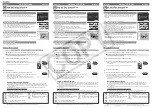
VMware, Inc.
45
Chapter 3 Deploying Applications
Deploying MSI Files on Microsoft Vista
When
you
deploy
MSI
files
on
Vista,
you
must
indicate
whether
an
installer
needs
elevated
privileges.
Typical
individual
user
installations
do
not
require
elevated
privileges
but
individual
machine
installations
require
such
privileges.
ThinApp
provides
the
MSIRequireElevatedPrivileges
parameter
in
the
Package.ini
file
that
specifies
the
need
for
elevated
privileges
when
the
value
is
set
to
1.
Specifying
a
value
of
1
for
this
parameter
or
forcing
an
individual
user
installation
from
the
command
line
can
generate
UAC
prompts.
Specifying
a
value
of
0
for
this
parameter
prevents
UAC
prompts
but
the
deployment
fails
for
machine
‐
wide
installations.
Controlling Application Access with Active Directory
You
can
control
access
to
applications
using
Active
Directory
groups.
When
you
build
a
package,
ThinApp
converts
Active
Directory
group
names
into
Security
Identifier
(SID)
values.
A
SID
is
a
small
binary
value
that
uniquely
identifies
an
object.
SID
values
are
not
unique
for
a
few
groups,
such
as
the
administrator
group.
Because
ThinApp
stores
SID
values
in
packages
for
future
validation,
the
following
considerations
apply
to
Active
Directory
use:
You
must
be
connected
to
your
Active
Directory
domain
during
the
build
process
and
the
groups
you
specify
must
exist.
ThinApp
looks
up
the
SID
value
during
the
build.
If
you
delete
a
group
and
re
‐
create
it,
the
SID
might
change.
In
this
case,
rebuild
the
package
to
authenticate
against
the
new
group.
When
users
are
offline,
ThinApp
can
authenticate
them
using
cached
credentials.
If
the
users
can
log
into
their
machines,
authentication
still
works.
Use
a
group
policy
to
set
the
period
when
cached
credentials
are
valid.
Cached
credentials
might
not
refresh
on
clients
until
the
next
Active
Directory
refresh
cycle.
You
can
force
a
group
policy
on
a
client
by
using
the
gpupdate
command.
This
command
refreshes
local
group
policy,
group
policy,
and
security
settings
stored
in
Active
Directory.
You
might
log
out
before
Active
Directory
credentials
are
recached.
Certain
groups,
such
as
the
Administrators
group
and
Everyone
group,
have
the
same
SID
on
every
Active
Directory
domain
and
workgroup.
Other
groups
you
create
have
a
domain
‐
specific
SID.
Users
cannot
create
their
own
local
group
with
the
same
name
to
bypass
authentication.
Active
Directory
Domain
Services
define
security
groups
and
distribution
groups.
If
you
use
nested
groups,
ThinApp
can
only
support
nested
security
groups.
Package.ini Entries for Active Directory Access Control
ThinApp
provides
the
PermittedGroups
parameter
in
the
Package.ini
file
to
control
Active
Directory
access.
When
you
start
a
captured
application,
the
PermittedGroups
parameter
checks
whether
a
user
is
a
member
of
a
specified
Active
Directory
group.
If
the
user
is
not
a
member
of
the
Active
Directory
group,
Thinapp
does
not
start
the
application.
For
information
about
restricting
packages
to
Active
Directory
groups,
see
“PermittedGroups”
on
page 73.
In
the
following
Package.ini
entry,
App1
and
App2
inherit
PermittedGroups
values.
[BuildOptions]
PermittedGroups=Administrators;OfficeUsers
[App1.exe]
...
..
[App2.exe]
...
...
Содержание THINAPP 4.6 - MIGRATING APPLICATIONS TECHNICAL NOTE
Страница 38: ...ThinApp User s Guide 38 VMware Inc...
Страница 114: ...ThinApp User s Guide 114 VMware Inc...
Страница 136: ...ThinApp User s Guide 136 VMware Inc...
Страница 140: ...ThinApp User s Guide 140 VMware Inc...
Страница 146: ...ThinApp User s Guide 146 VMware Inc...
















































